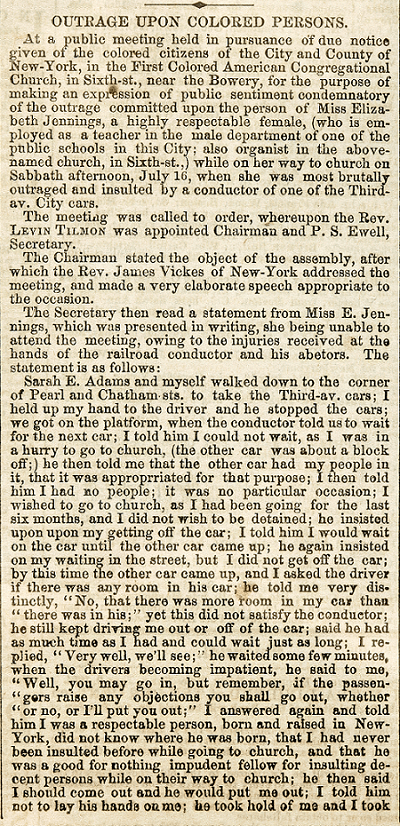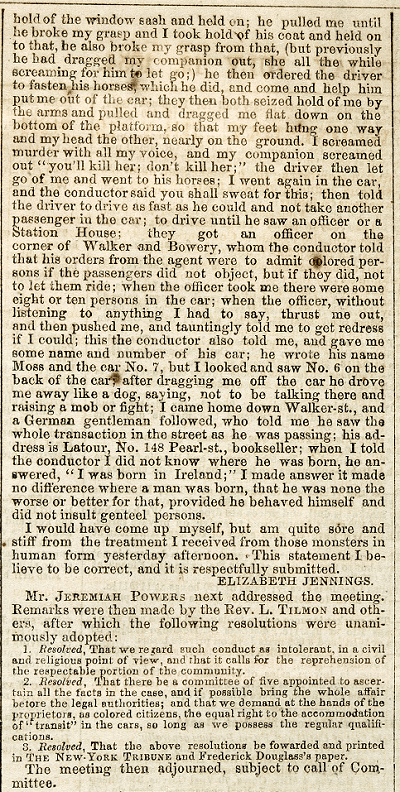Background
By 1804, every Northern state had passed laws to gradually abolish slavery. But this did not mean that racism against free Black people did not exist in the North. The prevalence of racism led to the formation of a segregated society where free Black people were not treated as the equals of white citizens. Free Black people founded their own schools and churches when they were not welcomed into established white institutions. Public services, like streetcar companies, established separate cars for white and Black customers so that white customers did not need to ride with people they believed were inferior. Although the separation of the races was never made into law, this social segregation forced free Black Americans to live like second-class citizens in their own communities.
About the Document
On July 16, 1854, 100 years before Rosa Parks refused to give up her seat on a Montgomery, Alabama, bus, Elizabeth Jennings was late for church. She boarded the first streetcar that arrived at her stop at the corner of Chatham and Pearl streets in New York City. But the conductor told her that the streetcar was for white passengers only. When Elizabeth refused to get off the streetcar, the conductor and a police officer forcefully removed her. She was left physically injured and humiliated by the ordeal.
Three days later, Elizabeth published a full account of the incident in the New-York Tribune newspaper. Her story sparked outrage in the free Black community of New York. Black community leaders decided to use her experience to challenge New York City streetcar segregation. With their support, Elizabeth sued the streetcar company. Her father hired future president Chester A. Arthur to represent his daughter in court. In 1855, a judge ruled in her favor, stating that no Black person could be denied the same services as a white person. Jennings’s victory was the first in a series of court victories that resulted in the end of streetcar segregation in New York City in 1865.
Vocabulary
- abetors (correct spelling: abettors): A person who helps someone commit a crime.
- appropriated: Saved.
- ascertain: Prove.
- Bowery: A neighborhood in New York City.
- cars: Streetcars.
- condemnatory: Strong disapproval.
- impudent: Disrespectful.
- proprietors: Owners.
- redress: Compensation.
- reprehension: Reprimanding.
- Sabbath: Sunday.
- segregation: The enforced separation of people of different races.
- streetcar: A public transportation vehicle roughly the size of a bus. In the 1850s, horses pulled streetcars.
- window sash: A window sill.
Discussion Questions
- How does Elizabeth Jennings’s retelling of her removal from the streetcar make you feel?
- Why did this incident spark such a strong reaction in New York City?
- What does this story reveal about the lives of free Black people in the antebellum North?
Suggested Activities
- APUSH Connection: 5.5 Sectional Conflict: Regional Differences
- Use these resources to illustrate for students that widespread racism and segregation existed in the North.
- Black women fought against the oppression of their people variety of ways. Teach these resources together with any of the following resources for a larger lesson about Black women’s activism: Salem Female Anti-Slavery Society, Conditional Manumission, Women and the Code Noir, Fighting for Freedom in New Amsterdam, Life Story: Elizabeth Freeman, Incidents in the Life of a Slave Girl, Resistance, Life Story: Harriet Robinson Scott, Life Story: Sojourner Truth, Life Story: Harriet Tubman, “All Bound Up Together,” Claiming Political Power, Laundry Workers’ Strike, Life Story: Susie Baker King Taylor, and Life Story: Elizabeth Keckley.
- Pair this resource with the Missouri Freedom Bond and the life story of Letitia Carson for a larger lesson about the challenges of being a free Black person in the antebellum United States.
- Elizabeth Jennings was able to live as a prosperous free Black woman despite many struggles. For more examples of free Black women succeeding against difficult odds in the antebellum period, see: Incidents in the Life of a Slave Girl, Salem Female Anti-Slavery Society, Freedom Bonds, Life Story: Sojourner Truth, Life Story: Letitia Carson, and Life Story: Elizabeth Keckley.
- The Supreme Court decision of Plessy v. Ferguson made the “separate but equal” accommodations for Black Americans that Elizabeth Jennings fought against legal. To learn about how this ruling affected the daily lives of Black Americans, read Life Story: Susie Baker King Taylor.
Themes
ACTIVISM AND SOCIAL CHANGE; AMERICAN IDENTITY AND CITIZENSHIP
New-York Historical Society Curriculum Library Connections
- For more on the history of the free Black community in New York, see New York Divided.










